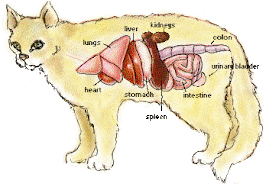AB1634 - California’s Proposed Cat Neutering Law
They’re rioting in Texas! The McAllen, Texas Monitor is adding fuel to the flames by reprinting an article from the Orange County, CA Register - they want nationwide protests. The government is getting into our private business again. What is the big deal? The furor is caused by a proposed California law, AB1634 that requires neutering of animals that come into contact with animal control officers. The owner will be fined (unless they neuter their pet, then). Oh whoa-is-me.
The proponents cite the hundreds of thousands of euthanized animals each year and the cost to catch and house them until they are put down. The detractors say, "It is not the government’s business". The proponents say that an un-neutered female cat can have 100’s of kittens in her lifetime. Actually the number varies depending on your source from 100 to 70,000 (including the offspring of the first cat’s kittens and grandkittens). The opponents say, "It is not the government’s business". No one even mentions the number of kittens that can be fathered by an un-neutered male cat. READ MORE;http://qualitycatresources.com/ab1634-californias-proposed-cat-neutering-law-2007-08-09
Monday, October 22, 2007
CALIFORNIA PROPOSED CAT SPAY / NEUTER LAW
Posted by
THE ALLEY CAT FORUM
at
7:16 PM
![]()
Labels: CAT, CAT ABCESS, CAT ADOPTION, cat care, CAT HEALTH, CAT SHELTERS, cat vets, ebay, GARFIELD, NEUTER, PET ALLERGIES, PETS, SPAY, VETERINARIAN
Friday, October 19, 2007
YOUR CATS HEARING
Hearing
The cat's outer ear (pinna) is connected by 27 muscles and can rotate 180 degrees to scan the environment or to direct its attention to a particular source of sound. Cats can detect higher frequencies than dogs (e.g., a mouse's ultrasonic squeak). They can discriminate with 75% accuracy between two sound sources separated by an angle of only 5 degrees. The direction of the source of sound can also be calculated by the cat sensing differences in the time of arrival and intensity of sound received by the two ears. Rodents don't have more than a sliver of hope of escape when this little tiger is on the prowl! READ MORE CAT FACTS:http://www.catsinternational.org/articles/senses_and_features/hearing.html
Posted by
THE ALLEY CAT FORUM
at
11:23 AM
![]()
Labels: CAT HEALTH, CAT HEARING, CATS BODY, CATS EAR PROBLEMS, CATS EARS, KITTEN CARE, KITTENS EARS, PET ALLERGIES, PET CAT, PETS
Tuesday, October 16, 2007
ALLERGIC TO CATS ? IT'S THE SALIVA NOT THE HAIR !
Cat allergy is by far the commonest allergy to pet animals and up to 40% of asthmatics are sensitive to cats. The cat allergen is much more likely to cause sensitisation than that of the dog.
The Cat Allergen
A tiny protein particle, the "Fel d 1" allergen is found mainly in the cat skin flakes and saliva. The protein is produced in the cat salivary glands and sebaceous glands of the skin. Cats are fastidious groomers, so they deposit the Fel d 1 protein on their fur by licking themselves.
An allergen is a material, which is capable of provoking an allergic reaction, such as pollen grain, dust mite or animal dander. Cat allergen — the allergy causing material from cats - is not cat hair but a protein present in the dander and saliva of cats. The allergens become airborne as microscopic particles, which when inhaled into the nose or lungs, can produce allergic symptoms.
Although individual cats may produce more or less allergen, there is no relationship between the pet’s hair length and allergen production, and no such thing as a non-allergic breed.
Male cats are more allergic than female cats, because testerone increases Fel d 1 production by the sebaceous glands.
Where is Cat Allergen found?
Cat allergen is present in largest amounts in homes with cats, but has also been found in homes where cats have never been present and in offices or public spaces where animals are not allowed. Cat allergen is particularly sticky and is carried on clothing from places with cats to other locations. It is almost impossible to not be exposed to some level of cat allergen. Of course, levels of exposure will be much higher where cats are present, and these levels are more likely to cause allergic symptoms.
Because cat allergen particles are particularly small (1/10 the size of dust mite allergen), they remain airborne for prolonged periods of time. Cat allergic individuals are more likely to have a rapid onset of symptoms when entering a room with cats, because there is always allergen, which is airborne and can be easily inhaled. Opening windows, using exhaust fans and using high efficiency air cleaners, can decrease the amount of airborne allergen.
Soft furnishings, such as carpets, sofas and mattresses, will hold cat allergen even after a cat has been removed from the home or banished from the bedroom. It has been shown that it can take as long as 20 weeks for levels of allergen in carpets to decrease to levels found in a home without a cat, and up to 5 years for cat allergen levels in mattresses to decrease to such levels. Removal or treatment of the carpet or sofa, and encasing of the mattress, will reduce the continued exposure to these reservoirs of allergen.
Cat allergen is also found on vertical surfaces such as walls. Attempts to decrease cat allergen exposure in a home should include wall cleaning. If the cat is removed to a restricted area of the home, it is important to realise that airflow through the duct system in a hot air heated home could spread the allergen. Efficient vent and furnace filters could help trap the allergens and reduce the spread. READ MORE:http://www.allergyclinic.co.nz/guides/7.html
Posted by
THE ALLEY CAT FORUM
at
8:01 AM
![]()
Labels: ALLERGIC TO CATS, ALLERGIES, ALLERGIES IN THE HOME, CAT ALLERGY, CAT HAIR, CATS, PET ALLERGIES, PET CAT, PETS, SALIVA, SNEEZING
Monday, October 15, 2007
SUPPLIES EVERY CAT OWNER NEEDS
If you are going to get a cat or kitten here is a list every cat household needs:
Litter box and litter. The litter box, or pan, should be shallow enough for the cat to jump into easily, but the sides should be high enough to contain scattered litter as the cat scratches in it. Commercially sold plastic litter boxes are excellent. Some have high-domed lids on them to keep flung litter from spreading throughout the house.
You probably won't have to worry about training your cat to use the litter box, but you will need to show your cat where to find it. Cats are fastidious and have a keen sense of smell. It is important to clean the pan daily.
Never place a litter box close to where the cat is fed, because cats believe these two duties are quite separate, and they will choose to do one or the other elsewhere. Many people put the litter box in the bathroom, away from high-traffic areas.
Cat dishes. Each cat should have his or her own food and water dishes. These must be shallow; cats like to keep their faces and whiskers clean while they eat.
Grooming tools. Although cats groom themselves, they generally love to be brushed and combed. Long-haired cats must be brushed daily to prevent their hair from matting. Even short-haired cats enjoy the attention and the stimulation of being personally attended to. Use a daily brushing ritual to keep an eye on your cat's overall health and on skin and coat conditions. Some rubber brushes have special teeth that dig down and remove loose dander and dead skin cells. Metal, fine-toothed combs are designed to extract fleas from the coat.
Nail clippers. You also can use human-nail clippers. Read our tips for trimming your cat's claws (see link below) and, if you have trouble convincing your companion to cooperate, ask your veterinarian or groomer for additional advice or a demonstration.
A scratching post. Cats can be easily trained to scratch on a scratching post instead of the sofa arm or mahogany table leg. The scratching post should be untippable and covered in sisal rope or the webbed reverse side of carpet (a fireplace log is also a good alternative). Do not cover the post with the same kind of fabric that you are trying to protect in your home—upholstery or carpeting. That will only confuse your cat.
An inviting bed. Cats will sleep where they want to, which is usually with you. If you do not want your cat in bed with you at night, you must provide a more appealing option, such as a soft pillow or an inviting old comforter. Anything soft and warm, especially if it has your scent on it, can attract your cat. But let your cat discover it; a cat who is forced to lie down on a restricted spot will summarily reject that spot. And consider rethinking your policy against animals in bed. A purring companion at your feet is a better sleeping aid than anything you can find in a drugstore.
Toys. Many common household items make great cat toys. Ping-Pong balls are fun to chase. Or you can make a "mouse house" by cutting a hole in the bottom and the side of a paper bag; flick a wad of paper inside the bag and watch your cat ingeniously fish it out.
Avoid string, ribbon, or rolls of yarn. Cats' barbed tongues make it difficult for them to spit anything out once they begin to swallow it. Besides the potential for choking, string can cause serious problems if ingested.
When buying commercial cat toys, pick one that you could give to an infant. There should be no parts that can come off and be swallowed. Keep small children's toys away from cats. Contrary to the myth that cats only eat what's good for them, toy soldiers have found their way into cats' digestive tracts.
Posted by
THE ALLEY CAT FORUM
at
3:03 PM
![]()
Labels: CAT ADOPTION, CAT BEDS, cat care, CAT SHELTERS, CAT SUPPLIES, CAT TOYS, cat vets, ebay, GARFIELD, HAPPY CAT, KITTEN CARE, KLIBAN, LITTER BOX, PET KITTEN, PETS
Sunday, October 14, 2007
HOW OLD IS A CAT IN HUMAN YEARS? CAT AGE CHART
Cat's Age Human's Age
6 months 10 years
8 months 13 years
1 year 15 years
2 years 24 years
4 years 40 years
8 years 48 years
12 years 64 years
14 years 72 years
16 years 80 years
18 years 88 years
20 years 96 years
21 years 100 years
It was once thought that 1 year in the life of a cat was equivalent to 7 years of a human life. Recently, a new scale has been accepted: after the first 2 years, the cat's life proceeds more slowly in relation to human life and each feline year is approximately 4 human years. The general consensus is that at about age 7 a cat can be considered "middle-aged," and age 10 and beyond "old."
Posted by
THE ALLEY CAT FORUM
at
3:13 PM
![]()
Labels: CAT ADOPTION, CAT AGE, CAT BEHAVIOR, CAT BODY, CAT HEALTH, CAT SITES, CAT VET, CAT VETERINARIAN, CAT YEARS, GARFIELD, KITTEN, KLIBAN, OLD CAT, PET CAT, PETS
Saturday, October 13, 2007
WHEN IS KITTEN SEASON
Posted by
THE ALLEY CAT FORUM
at
1:15 PM
![]()
Labels: ANIMAL SHELTERS, BLACKWHITE CAT, BREEDING, CAT BREEDING, CAT BREEDS, CAT HEALTH, CAT TOYS, CATS, KITTEN, KITTENS, PET CAT, PETS, SPAY





















 Custom
Custom 

